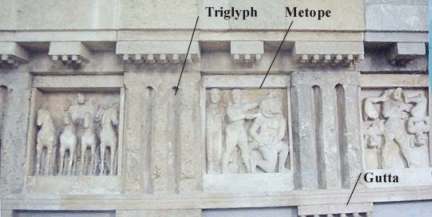 Temple from Templum is the same word as the Greek temenos, from temnw to cut off, means to separate some special place from the rest of the land. Usually religion rites were held outside the temple in front of the temple at an altar. With a few exceptions (for example temple to Apollo on Delos) most temples face east as the priests faced the direction of the rising sun when making offerings to the gods.
Temple from Templum is the same word as the Greek temenos, from temnw to cut off, means to separate some special place from the rest of the land. Usually religion rites were held outside the temple in front of the temple at an altar. With a few exceptions (for example temple to Apollo on Delos) most temples face east as the priests faced the direction of the rising sun when making offerings to the gods.
A shrine is stronger than a tower to save, A shield that none may cleave. Aeschylus The Suppliants
Persons were protected in the sacred space of the Temenos, they could not be taken out without their will. They enjoyed the right of asylia (or today asylum, from sylan “to steal”, ) (the right not to be taken or stolen out).
Doric Temples
Greek Doric temples have usually a pattern under the pediment known as triglyphs (three cuttings) and metopes. The triglyphs alternate with the metopes across the front of the temple. Triglyphs have three parts, and then in between the triglyphs are the metopes. The frieze often was an alternating set of triglyphs and metopes.
The Doric and Ionic Order are the main structural systems of Greeks temples (type of column, decoration, etc). The third so-called Corinthian Order is similar to the Ionic Order with differences mainly in the column decoration.
Continue reading Temples and the Doric, Ionic and Corinthian Orders






























